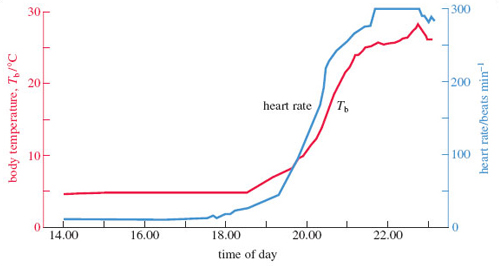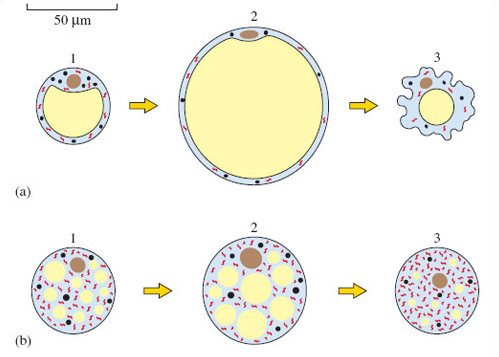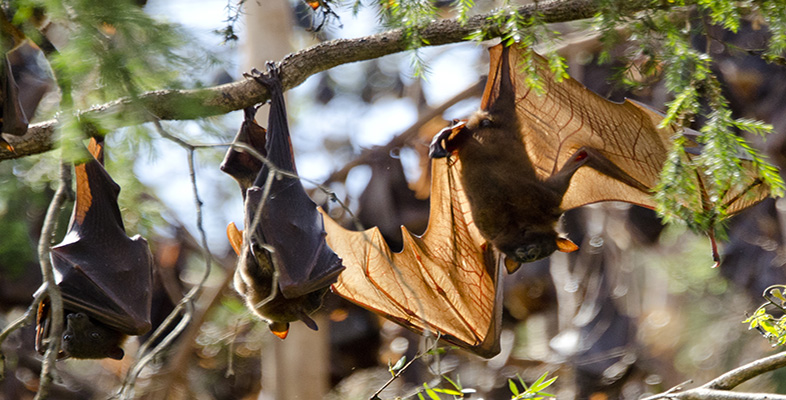6.2 Opting out
This last section of the course contains, I think, some of the most challenging science that you have met so far. Take it slowly, translating all the abbreviations in your head as you come to them (read BAT as 'brown adipose tissue', for example) and looking carefully at the graph in Figure 8 and at Figure 9, remembering to read the captions. Don't allow yourself to get 'bogged down' if you don't understand something first time; continue to the end of the section and then read the advice in the box at the end.
Hibernation is a more radical and extended adjustment than torpor. Insect eaters that are able to store sufficient amounts of fat in their bodies can undergo hibernation in response to the low ambient temperatures of winter. For shrews, a combination of high metabolic rate and small body size means that this particular physiological feat seems beyond them. By contrast, although some bats display torpor on almost a daily basis, many other species, especially those living in cool climates, undergo genuine hibernation.
Activity 8
Watch 'The Insect Hunters' from 39.58-42.54, which shows overwintering in little brown bats, and make brief notes. From your close observations, especially of the pictures from the thermal imaging camera, describe how the bats hibernate and then define hibernation.
Discussion
During hibernation, the bats are very cold and hang upside down in a profound form of sleep. Periodically the bats warm up and arouse, in order to drink water - though the males might indulge themselves in other respects. On this evidence, hibernation is a prolonged winter sleep in a sheltered but cold spot, during which the animal's body temperature plummets, interrupted by brief periods of arousal. Thus, true 'deep' hibernation consists of successive bouts of torpor, interrupted by arousal.
The flying insects preyed upon by bats are scarce or absent in winter, the very time when bats would need extra energy to maintain a high body temperature. Before hibernation, bats build up stores of fat in their body, and some such stores have an important role during arousal, as I'll explain shortly.
Biologists used to believe that hibernating animals simply allowed their body temperatures to drop passively to that of the burrow or cave in which they spend the winter. More recent research has shown that body temperature is tightly controlled during entry into hibernation and during hibernation itself. Data from a much larger insect eater, the hedgehog, is of special interest.
Hedgehogs in Britain hibernate from around November to April, with precise timings dependent on weather conditions. They become aroused from hibernation about every 7-11 days. Temperature and heart rate during hedgehog hibernation have been measured for long periods via miniature sensors implanted into the animal. Figure 8 shows body temperature (Tb) and heart rate readings during a period of deep hibernation (for four hours from 14.00 to 18.00, i.e. 2 p.m. to 6 p.m.), and during a subsequent period of spontaneous arousal (18.00-23.00, i.e. 6-11 p.m.).
SAQ 8
Read off the graph the values of Tb and heart rate before arousal. (Figure 8 has two different vertical axes; the left axis shows the values for Tb, so run your eyes to the left as you read off the Tb values. Refer to the right axis for heart rate values.)
Answer
During deep hibernation, Tb of the hedgehog was about 4 °C. Heart rate is more difficult to determine but is a very approximately 10 beats per minute.

Compare the very low heart rate during hibernation with the normal heart rate of 250-300 beats per minute when the hedgehog is active. Breathing rate is also reduced sharply in the hibernating hedgehog, down to just one breath per hour, compared to 25-50 breaths per minute in an active individual. Prolonged periods of breath-holding, known as apnoea, have been observed in hibernating hedgehogs, with a 'record' breath-hold of 150 minutes.
A hibernating hedgehog may appear lifeless and not subject to any physiological control, but this is far from the case. When not hibernating, the hedgehog, like all mammals to a greater or lesser extent, maintains its Tb around a set-point. If Tb falls below or rises above 35-36 °C, physiological mechanisms come into play to warm or cool the hedgehog's body as appropriate. You can think of the control mechanisms as being similar to those that control a central heating system to maintain your house at a comfortable temperature. If the temperature of a room falls below that set by the thermostat, the heating is switched on; if the room temperature is too hot, the thermostat switches off the heating. The thermostat of the hedgehog has no known physical basis but it is clear that heating and cooling of the body is controlled by a special area in the brain, the hypothalamus. If a non-hibernating hedgehog gets too cold (Tb dropping below 35-36 °C), the heating is switched on - shivering and increases in metabolic rate (see course S182_1) take place. If the body temperature of the hedgehog exceeds the set Tb, the heating mechanisms are switched off.
During hibernation, the set Tb is reduced to just 4 °C, analogous to turning down the thermostat to 4 °C in your central heating system. If the hedgehog's Tb drops below 4 °C during hibernation, the animal will react by increasing its heart and breathing rate and its rate of metabolism, generating sufficient extra heat to raise its body temperature. Arousals are provoked by chilling but, as you have seen, many arousals occur spontaneously.
SAQ 9
Figure 8 shows changes in heart rate and Tb during spontaneous arousal, beginning at 18.00. Describe the pattern of changes shown in the graph.
Answer
Heart rate increases from below 10 beats per minute to a maximum of about 300 beats per minute by 23.00. Tb increases from 4 °C to a maximum of over 25 °C at 23.00.
Why hedgehogs, and hibernators in general, become aroused periodically is not fully understood. Hibernating hedgehogs spend a total of about 80% of the time with a very reduced Tb, waking up between 15-22 times during a hibernation period.
During arousal, the body is warmed up by fat breakdown in BAT (brown adipose tissue or brown fat), which is very different from the more familiar white fat (white adipose tissue, or WAT). What we commonly think of as fat consists of masses of WAT cells, each loaded with a large round fat vacuole (Figure 9a). Traditionally, WAT has been viewed as a storage tissue that animals draw on during prolonged exercise, or in 'emergencies' when they are short of food. (Recently, WAT has been found to have more complex structures and a wider range of functions than was believed.) Breakdown of the fat contained in WAT into its constituent building blocks (the most significant types are called fatty acids) is the first step to releasing the chemical energy used to fuel metabolism. Prior to hibernation, hedgehogs and bats build up stores of WAT. BAT normally builds up too during this period.

BAT consists of masses of somewhat smaller cells, but each has a number of small fat droplets, and also reserves of a 'storage' carbohydrate, glycogen (Figure 9b). What is remarkable about BAT is that its primary function is the generation of heat. In most other types of cell, metabolism is geared in such a way that the breakdown of fuels such as fatty acids and glucose releases energy in a chemically useful form. This 'captured' energy can be used within such cells to maintain all the energy-demanding 'housekeeping' activities, such as synthesising macromolecules, or transporting different chemical building blocks around the cell. But the breakdown of fatty acids in BAT (the final stages of which occur in the mitochondria) releases energy not so much in the form of these neat 'parcels' of chemical energy but as heat. Once BAT becomes switched on in this way, blood circulating through BAT is warmed and the warmed blood circulates throughout the body, raising Tb. Indeed, the endearingly termed 'bat BAT' has a vital role in arousal.
SAQ 10
From your observations on thermal imaging of the little brown bats during arousal (the TV programme extract from 41.40-42.52), suggest the location of BAT in these animals and describe the spread of heat throughout the bat's body.
Answer
Thermal imaging shows a large hotspot behind the neck, between the shoulder blades, the likely position of a large depot of BAT. Heat released by breakdown of fat (and glycogen) in the BAT spreads around the body. The head appears to be the warmest; the rest of the body and the limbs less so.
So the use of thermal imaging provides a wonderful insight into the role of BAT in arousal of hibernating bats. But why arousal is necessary remains a mystery, especially since it uses up so much of the precious energy reserves of the body. Little brown bats do not feed during arousal, but as you've seen, they drink water. Perhaps doing so helps them get rid of accumulated toxic wastes via urination, but this explanation is by no means certain. This question is just one further example of just how little is known about bats, which only increases a sense of wonder about these intriguing mammals.
How did you get on with this last section? If you found it difficult, don't worry. Read through it once more and see if that helps. If you plan to study the next course in this series, move on to S182_3 Studying mammals: chisellers and promise yourself that you will come back and reread the section later. You will probably find that it seems much more straightforward when you look at it again.
Now that you are at the end of this free course, read through the learning outcomes in the course introduction and consider making notes on them
At this point, you may feel that you would like to explore some aspects of insect eaters in more detail. The BBC website provides links to valuable resources for obtaining much more information about mammals of all sorts and if you are able to, now might be a good time to investigate what is available.
